Boeing 307 Stratoliner
The Boeing Model 307 Stratoliner was an American commercial transport aircraft that entered commercial service in July 1940. It was the first to offer a pressurized cabin, allowing it to cruise at an altitude of 20,000 ft (6,000 m), well above many weather disturbances. The pressure differential was 2.5 psi (17 kPa), so at 14,700 ft (4,480 m) the cabin air pressure was equivalent to an altitude of 8,000 ft (2,440 m). The Model 307 had capacity for a crew of six and 33 passengers. The cabin was nearly 12 ft (3.6 m) across. It was the first land-based aircraft to include a flight engineer as a crew member (several flying boats had included a flight engineer position earlier).[1] In addition to its civilian service it was also flown as the Boeing C-75 Stratoliner by the United States Army Air Forces, who used it as a long-range cargolift aircraft.
| Boeing 307 Stratoliner C-75 | |
|---|---|
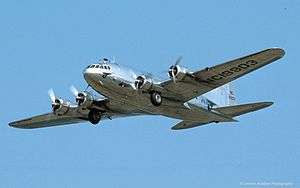 | |
| A restored Boeing 307 (NC19903) on its final flight in 2003 | |
| Role | Airliner |
| National origin | United States |
| Manufacturer | Boeing |
| First flight | December 31, 1938 |
| Introduction | July 4, 1940 with Pan American Airways |
| Retired | 1975 |
| Status | Retired |
| Primary users | Transcontinental & Western Air Pan American Airways United States Army Air Forces |
| Number built | 10 |
| Unit cost |
$315,000 in 1937[1] (equivalent to $5.6 million today) |
| Developed from | Boeing B-17 Flying Fortress |
Development and design
In 1935, Boeing designed a four-engine airliner based on its B-17 heavy bomber (Boeing Model 299), then in development, calling it the Model 307. It combined the wings, tail, rudder, landing gear, and engines from their production B-17C with a new, circular cross-section fuselage of 138 in (351 cm) diameter,[2] designed to allow pressurization.[3]
The first order, for two 307s (named Stratoliners), was placed in 1937 by Pan American Airways. Pan Am soon increased this to six, and a second order for five from Transcontinental & Western Air (TWA) prompted Boeing to begin production on an initial batch of the airliner. Pan Am received its initial order and TWA received its order, but only one of the second batch of four Pan Am aircraft was delivered before war intervened and put a halt to civil aircraft production.[3][4][5]
C-75 conversion
At the time the United States entered World War II in December 1941, flying across oceans was a rare luxury. The war required government and military officials to do so, and most four-engined long-range commercial aircraft, including Pan American Airways' 14 flying boats and TWA's five Boeing 307s, were pressed into service. Additional fuel tanks were added to give them the extra range required; once converted they were designated C-75 for military use. Before World War II ended their production, ten commercial 307s had been built. TWA flew domestic routes between New York and Los Angeles for 18 months until the Army purchased their Stratoliners for wartime use as long-range, transatlantic transports for various VIPs or critical cargo on January 26, 1942.[6] TWA converted their 307s to military service in January 1942,[7] and its Intercontinental Division (ICD) then operated these C-75s under contract to the Army's Air Transport Command (ATC) until July 1944.[2] These were the only U. S. built commercial aircraft able to cross the Atlantic with a payload until the arrival of the Douglas C-54 Skymaster in November 1942.
Conversion to the C-75 included removal of the pressurization equipment to save weight, removal of the forward four (or five) of nine reclining seats along the port side, and alteration of the two forward Pullman-like compartments (of four) starboard of the left-of-centerline aisle. Space was thus provided for crew requirements on extremely long flights and for the addition of five 212.5 U.S. gal (804 L; 177 imp gal) fuel tanks. The landing gear was strengthened, the maximum takeoff weight was increased from 45,000 to 56,000 lb (20,400 to 25,400 kg), and the exterior was painted military olive drab.[2]
Operational history
The maiden flight of the first Boeing 307 Stratoliner (not a prototype, as it was planned to be delivered to Pan Am following testing and certification), registration NX 19901 took place from Boeing Field, Seattle on December 31, 1938.[8]
This aircraft crashed on March 18, 1939, while being demonstrated to representatives of KLM. After takeoff the aircraft climbed to an altitude of 11,000 feet. At this altitude, longitudinal stability tests were made. The next tests, as outlined by the flight plan, were side-slip tests. The aircraft went into an inadvertent spin subsequent to a stall at an altitude of approximately 11,000 feet. It made two to three turns in the spin, during which the engines were used to aid recovery. In recovering from the dive subsequent to the spin, the wings and horizontal tail surfaces failed upward apparently due to air loads in excess of those for which the aircraft was designed. The ten people aboard, including the KLM technical director, a representative of the Dutch Air Ministry, a Boeing test pilot, the Boeing Chief Aerodynamicist, the Boeing Chief Engineer, and a TWA representative were killed.[9][10] Subsequent wind tunnel testing showed that the addition of an extended dorsal fin ahead of and attached to the vertical tail prevented rudder lock. This was incorporated into the 307's rudder redesign, while also being incorporated in Boeing's rear fuselage redesign for their models "E" through "G" B-17 bomber.[11]
The first delivery to a customer was to multi-millionaire Howard Hughes, who bought one 307 (NX-19904) for a round-the-world flight, hoping to break his own record of 91 hours 14 minutes set from July 10–14, 1938 in a Lockheed 14. Hughes' Boeing Stratoliner was fitted with extra fuel tanks and was ready to set out on the first leg of the round-the-world attempt when Nazi Germany invaded Poland on September 1, 1939, causing the attempt to be abandoned. This 307 later had the extra fuel tanks removed, was fitted with much more powerful Wright R-2600 engines, and was transformed into the luxurious "The Flying Penthouse" for Hughes, although it was little used, eventually being sold to oil tycoon Glenn McCarthy in 1949.[12][13]
Deliveries to Pan Am started in March 1940, with TWA receiving its first 307 in April. TWA's Stratoliners flew three-stop flights between Los Angeles and New York while Pan Am's flew from Miami to Latin America. Ten 307s were built, three being delivered to Pan-Am (NC-19902:Clipper Rainbow, NC-19903:Clipper Flying Cloud, and NC-19910:Clipper Comet) and five to TWA (NC-19905:Comanche, NC-19906:Cherokee, NC-19907:Zuni, NC-19908:Apache, and NC-19909:Navajo) with one aircraft going to Hughes (NX-19904).[14]
On the entry of the United States into World War II, Pan Am (PAA) continued operating its Stratoliners on routes to Central and South America, but under direction of the Army Air Forces' Air Transport Command,[15] while the TWA 307s were sold to the United States government, being designated Boeing C-75 (42-88623/27) and operated by the United States Army Air Forces (although normally still flown by TWA crews).[16]
The Army returned its five C-75s to TWA in 1944, which sent them back to Boeing for rebuilding. Boeing replaced the wings and horizontal tail with those from the B-17G, while more powerful engines were fitted and the electrical system was replaced with one based on the B-29 Superfortress. Passenger capacity was increased from 33 to 38.[17] The total rebuilding cost to TWA was $2 million; the five aircraft re-entered passenger service on April 1, 1945. Although TWA was committed to the larger and faster Lockheed Constellation, it kept the Stratoliners until April 1951.[18]
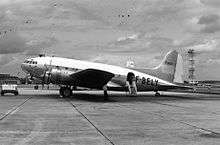
Pan Am flew its unmodified 33-passenger Stratoliners between Miami and Havana until 1947, then sold them to small operators, including Aerovias Ecuatorianas AREA). Some later returned to the US, whilst others went to South-East Asia to replace write-offs. One aircraft (N-19903) was purchased by the Haitian Air Force, being fitted as a Presidential transport for François "Papa Doc" Duvalier. This aircraft later returned to the U.S. and was purchased by the Smithsonian Museum.[19]
TWA sold its Stratoliner fleet, of five, to the French airline Aigle Azur, which used them (F-BELU, F-BELV, F-BELX, F-BELY, F-BELZ) on scheduled flights from France to North and Central Africa, and later to French Indo-China. Three aircraft were transferred (F-BELU, F-BELV, F-BELX) to Aigle Azur's Vietnamese subsidiary (Aigle Azur Extrême-Orient) and were used in South East Asia, in various liveries and with various registrations, with at least one aircraft remaining in commercial use until 1974.[20] Two aircraft remained in Europe (F-BELY, F-BELZ) and passed to Mediterranean runs, especially around Corsica, with: Airnautic. The exact history of the five aircraft becomes quite complex as the subsidiary was sold to UAT in 1955, and this in turn merged to become UTA in 1963, whilst the original branding was kept until 1961. Also, some of these aircraft were under contract to the ICC/CIC [see below], running both ad hoc flights plus regular scheduled services for diplomats between the various, often hostile, capitals. Aircraft write-offs required buying-up some of the remaining 307s, for ease of maintenance and continuity of service, so F-BELY also went East, as did the ex-Pan Am F-BHHR. At various times following independence, most received local (usually Lao) registrations (XW-PGR; XW-TAA, XW-TAB, XW-TAC; XW-tFP, XW-TFR), possibly for legal/fiscal reasons, whilst maintaining essentially the same services. Some were registered to the CITCA leasing company, whilst some formed the basis of the national-carrier Royal Air Lao.
C-75
Two main routes were flown: Washington, D.C., to Cairo across the South Atlantic, and New York to Prestwick, Scotland, across the North Atlantic.[21] They often flew non-stop the 2,125 statute miles (3,415 km) between Gander, Newfoundland and Prestwick, Scotland in the north, and the 2,550 statute miles (4,100 km) between Natal, Brazil and Accra, Ghana in the south. After July 1942 a refueling stop at Ascension Island was an option in the south.[22] In the north, stops at Iceland or Greenland were often necessary, especially flying westbound against the prevailing winds. As C-54s took over the Gander to Prestwick route, the C-75s operated a Marrakech-to-Prestwick service out over the Atlantic.[21]
In April 1945, the five C-75s were returned to TWA, having been restored by Boeing and recertified by the CAA as SA-307B-1 civilian transports with their old registration numbers. TWA then restyled the interior cabin in two sections, ten seats forward and 28 aft.[2]
Variants
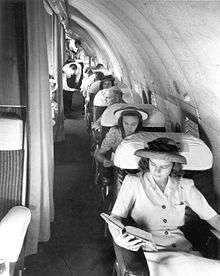
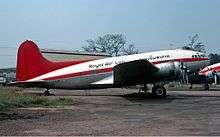
- 300
- original concept designation of 307.
- 307
- equipped with Wright Cyclone GR-1820-G102 engines with single-speed supercharger; five crew.
- 307B
- equipped with Wright Cyclone GR-1820-G105A engines with two-speed supercharger for improved high altitude performance; seven crew.
- C-75
- Five Trans World 307Bs were pressed into service with the USAAF as military transports: 42-88623/24/25/26/27; the cabin pressurization was removed to save weight.
- 307B-1
- Following military service, the C-75s were overhauled and updated with B-17G wings and tailplane, four Wright Cyclone GR-1820-G606 engines, and B-29-type electronics.
Airframes
Only 10 airframes were ever built:
- NX-19901: 18 March 1939: crashed on a test-flight. 10 killed.
- N-19902: PanAm: Clipper Rainbow. 1951:sold to Aigle Azur, to Far East subsidiary Aigle Azur Extrême-Orient, as: F-BHHR. 22 May 1961: DBR. 4+28: none killed.
- N-19903: PanAm: Clipper Flying Cloud. sold to Haiti: Duvalier.[23][24][25] now static at: Smithsonian.
- N-19904: to Howard Hughes (The Flying Penthouse). now non-flying: a boat.[sic].
- N-19905: TWA: C-75: 42-88624. sold, as: F-BELV, to Aigle Azur, to Far East subsidiary Aigle Azur Extrême-Orient; to CITCA. 18 October 1965: missing. 4+9: all 13 MPD.(CIC weekly flight).
- N-19906: TWA: C-75: 42-88623. sold, as: F-BELU, to Aigle Azur, to Far East subsidiary Aigle Azur Extrême-Orient; to CITCA.(&: CIC).[26] sold: XW-TFP.[27] 13 March 1975: crashed. 2+0: none killed.
- N-19907: TWA: C-75: 42-88625. sold, as: F-BELX.(&: CIC). sold, as: XW-TFR. 27 June 1974: crashed. 19 (2+17) of 39 (6+33) killed.
- N-19908: TWA: C-75: 42-88626. sold, as: F-BELY. sold, as: XW-PGR. 27 February 1971: DBR w/o.[28]
- N-19909: TWA: C-75: 42-88627. sold, as: F-BELZ, to Aigle Azur. 29 December 1962: crashed. all 25 (3+22) killed.
- N-19910: PanAm: Clipper Comet. to: AV Ecuatorianas, as: HC-004. to Quaker City Airways:, as: N-75385. 10 May 1958: crashed. 2+0: none killed.[29]
Operators
Civilian operators
- Howard Hughes bought one aircraft (NX-19904).[notes 1]
- Pan American Airways (PAA: Pan Am) received three aircraft (NC-19902/03/10).[notes 1]
- Trans World Airlines (TWA) received five aircraft (NC-19905/06/07/08/09).[notes 1]
- Quaker City Airways,[30] as: N-75385 (ex-PanAm: NC-19910).[31]
- Compagnie Haïtienne de Transports Aériens (CoHaTA: CoHata), as: 2003[34] (ex-PanAm: NC-19903) an interesting history, as photographs and airline-schedules[23][35] clearly show the aircraft was intended for civil aviation and did serve in this role;[36] however, it was soon appropriated as the personal transport of the President.[37]
- Aigle Azur ex-TWA aircraft bought in 1951 with replaced B-17G engines and wings: F-BELU,[26] F-BELV, F-BELX, F-BELY, F-BELZ.
- Commission Internationale de Contrôle (CIC): aircraft of Aigle Azur and/or its numerous affiliates, including the leasing company CITCA, that were under regular contract to the International Control Commission (ICC) kept the livery, but dropped the airline-name in favour of the ICC abbreviation in French inscribed on the stabilizer: F-BELU (NC-19906),[38] F-BELV (NC-19905), F-BELX (NC-19907).[39]
- Airnautic F-BELY (NC-19908),[40] F-BELZ (NC-19909).
- Royal Air Lao received ex-Aigle Azur, as: XW-PGR (F-BELY/NC-19908), XW-TFP (F-BELU/NC-19906).
- Royal Air Cambodge still under French codes, as: F-BELV (ex-TWA: NC-19905).[41]
- Cambodia Air Commercial as: XW-TFR (F-BELX/NC-19907): curious registration, as Cambodian national code is: XU. XW-TFR has same pattern registration as Royal Air Lao, so this airline might have been a Lao franchise for the Cambodian internal network.
Military operators
- Haitian Air Force, as presidential transport: 2003 (ex-PanAm: NC-19903).
- United States Army Air Forces, the five TWA 307Bs were pressed into service and designated as C-75s: 42-88623/24/25/26/27. The three Pan Am 307s were also operated for the USAAF during World War II but retained civil registrations and were not redesignated.
Accidents and incidents
According to the Aviation Safety Network, the Boeing 307 was involved in eight hull-loss incidents for a total of 67 fatalities. Four of the eight incidents were fatal, with one an apparent shoot-down in a zone of conflict; casualties, by number, in the four incidents were: 25, 19, 13 & 10 (total: 67).[42]
- March 18, 1939: the first Boeing 307 (NX19901) crashed in the old town of Alder, near Mt. Rainier, during a demonstration flight for KLM, killing all ten on board. The aircraft went into a spin. The pilot attempted to recover, but this caused the aircraft to break up.[43]
- May 10, 1958: a Quaker City Airways Boeing 307 (N75385) force-landed near Madras, Oregon, after an explosion and fire in the cabin, possibly due to a fuel leak; the aircraft was consumed by the fire. Both pilots survived; the aircraft was on a test flight (ex-PanAm: NC-19910; ex-Ecuatorianas: HC-004).[44]
- May 22, 1961: an Aigle Azur Extrême Orient Boeing 307 (F-BHHR) was blown off the runway and crashed at Tan Son Nhat International Airport while landing after the number four engine failed in flight; all 28 passengers and crew survived, but the aircraft was written off. The aircraft was operating a non-scheduled Saigon-Vientiane service. (ex-PanAm: NC-19902).[45]
- December 29, 1962: an Airnautic Boeing 307B-1 (F-BELZ) crashed into Monte Renoso on Corsica due to crew error while on a Bastia-Nice-Ajaccio-Nice-Bastia flight, killing all 25 (3+22) passengers and crew on board in the worst-ever accident involving the 307. (ex-TWA: NC-19909).[46]
- October 18, 1965: an ICC Boeing 307B-1 (F-BELV) disappeared while on a non-commercial but scheduled Vientiane-Hanoi passenger service with 13 (4+9) on board; the aircraft was probably shot down. The aircraft was leased from Compagnie Internationale de Transports Civil Aériens (CITCA). (ex-TWA: NC-19905).[47]
- February 27, 1971: a Royal Air Lao Boeing 307B-1 (XW-PGR) struck a Royal Lao Air Force Douglas C-47 while landing at Luang Prabang, damaging the left wing; the aircraft was not repaired due to a lack of spare parts. (ex-TWA: NC-19908; ex-F-BELY).[48]
- June 27, 1974: a Cambodia Air Commercial Boeing 307B-1 (XW-TFR) force-landed in a rice field minutes after takeoff from Battambang Airport en route to Phnom Penh due to improper maintenance causing the failure of three engines; the right wing struck a tree and separated just before landing. 19 (2+17) of 39 (6+33) on board died. (ex-TWA: NC-19907; ex-F-BELX). [49]
- March 13, 1975: a Royal Air Lao Boeing 307B-1 (XW-TFP) force-landed in the Mekong River in Laos while on a Hong Kong-Vientiane cargo service; both pilots (who survived) were held prisoner by the Pathet Lao before being released in May 1975. The aircraft was located in 1986. (ex-TWA: NC-19906; ex-F-BELU).[50]
Surviving aircraft
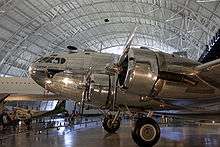
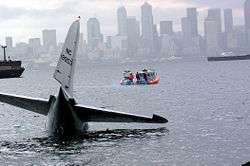
The only surviving Boeing 307 Stratoliner (NC-19903) is preserved in flying condition at the Smithsonian Museum's Steven F. Udvar-Hazy Center. On March 28, 2002, this aircraft crashed into Elliott Bay in Seattle, Washington, on what was to be its last flight before heading to the Smithsonian.[51] Despite the incident, it was again restored, flown to the Smithsonian, and is now on display.[52]
The fuselage of Howard Hughes' personal 307 (NX-19904) also survives, although it has been converted into a houseboat.[53] The aircraft was awaiting restoration at Fort Lauderdale International Airport in the early 1960s when it was severely damaged in a hurricane after its tiedowns failed and it was blown into a stand of trees. The aircraft languished for nearly a year before being removed and longer still until later salvaged for its conversion into the house boat. The interior is notable for the original finishes and fitments added by Howard Hughes.[54][55][56] The boat is now part of the collection at the Florida Air Museum.[57]
Specifications (Boeing 307)
Data from Jane's AWA 1942 (apart from wing area and loading)
General characteristics
- Crew: five: two pilots, flight engineer, two cabin crew
- Capacity: 38 passengers in daytime, 25 by night
- Length: 74 ft 4 in (22.6 m)
- Wingspan: 107 ft 0 in (32.63 m)
- Height: 20 ft 9.5 in (6.33 m)
- Wing area: 1,486 sq ft (138 m2)
- Empty weight: 30,000 lb (13,608 kg)
- Gross weight: 45,000 lb (20,420 kg)
- Powerplant: 4 × Wright GR-1820-G102A radial engines, 1100 hp (820 kW) each
Performance
- Maximum speed: 241 mph (387 km/h, 209 kn)
- Cruise speed: 215 mph (344 km/h, 187 kn)
- Range: 1,750 mi (2,820 km, 1,520 nmi)
- Service ceiling: 23,300 ft (7,110 m)
- Wing loading: 28 lb/sq ft (138 kg/m2)
- Power/mass: 0.098 hp/lb
See also
Related development
Aircraft of comparable role, configuration and era
Related lists
References
- "Boeing 307 Stratoliner". The Aviation History Online Museum. Archived from the original on February 1, 2014. Retrieved January 28, 2012.
- Betts, Ed. "The Boeing Stratoliners and TWA". American Aviation Historical Society Journal, Volume 38, Issue 3, 1993.
- Hardy, Air International January 1994, p. 21.
- Bowers 1989, p. 231.
- Dietrich, Noah; Thomas, Bob (1972). Howard, The Amazing Mr. Hughes. Greenwich: Fawcett Publications, Inc. p. 148.
- "Stratoliners Given To Army". The San Bernardino Daily Sun. 48. San Bernardino, California. January 27, 1942. p. 1.
- Jane's Fighting Aircraft of World War II. London: Random House, 1989. ISBN 1-85170-199-0.
- Ford 2004, p. 55.
- Air Safety Board Report involving NX19901, of the Boeing Aircraft Company, near Alder, Washington, March 18, 1939
- "Crash photo". Breme (in Serbian). Belgrade. April 2, 1939. Retrieved March 17, 2020.
- Abzug, Malcolm J. and E. Eugene Larrabee. Airplane Stability and Control: A History of the Technologies that Made Aviation Possible. Cambridge, UK: Cambridge University Press, 2005. ISBN 978-0-521-02128-9.
- Hardy, Air International, January 1994, pp. 22–23.
- "Houston's Aviation History Timeline". The 1940 Air Terminal Museum. Archived from the original on October 8, 2006. Retrieved January 28, 2012.
- Munson 1972, p. 182.
- Taylor 1979, p.59.
- Hardy, Air International February 1994, p. 69.
- Bowers 1989, pp. 234–235.
- Hardy, Air International February 1994, p. 70.
- Hardy, Air International February 1994, p. 71.
- Hardy, Air International February 1994, pp. 70–72.
- Berry, Peter. "Transatlantic Flight 1938–1945 (Part I 1938–1943)". AAHS Journal, Volume 40, Issue 2, 1995.
- Berry, Peter. "Transatlantic Flight 1938–1945 (Part II 1943–1945)". AAHS Journal, Volume 40, Issue 3, 1995.
- "CoHata d'Haiti". 1958. Retrieved May 21, 2020 – via Timetable Images.
- "Boeing 307 N19903". Goleta Air and Space Museum. Retrieved May 21, 2020.
- "ASN Aircraft accident Boeing S.307 Stratoliner N19903 Elliott Bay, WA". Aviation Safety Network. Flight Safety Foundation. Retrieved May 21, 2020.
- "Boeing SA-307B-1 Stratoliner". January 31, 2008. Retrieved May 21, 2020 – via 1000 Aircraft Photos.
- "Royal Air Lao 307 Stratoliner". March 11, 1975. Retrieved May 23, 2020 – via AirlineFan.com.
- "Aircraft Data XW-PGR, 1940 Boeing SA-307B-1 Stratoliner C/N 2000". Airport-Data.com. Retrieved May 22, 2020.
- "ASN Aircraft accident Boeing S.307 Stratoliner N75385 Madras, OR". Aviation Safety Network. Flight Safety Foundation. Retrieved May 21, 2020.
- Civil Aeronautics Board Reports. 28. US. 1958. Retrieved May 23, 2020.
- "Crash of a Boeing 307 Stratoliner near Madras". Bureau of Aircraft Accidents Archives. US. May 10, 1958. Retrieved May 23, 2020.
- "Boeing, Type 307, Stratoliner | Catalog #: 01_00091312". Retrieved May 22, 2020 – via Flickr.
- "Profile for: AREA Ecuador". Archived from the original on March 4, 2016. Retrieved January 27, 2014.
- "Compagnie Haitienne de Transports Aeriens CoHaTA Boeing 307 Stratoliner Photo". eBay. Retrieved May 23, 2020.
- "CoHaTA Airlines of Haiti Boeing 307 Stratoliner Ad | #152980399". Worthpoint. Retrieved May 23, 2020.
- "Haiti Air Force". aeroflight. UK. March 1, 2006. Retrieved May 23, 2020.
- "Compagnie Haitienne de Transports Aeriens CoHaTA Boeing 307 Stratoliner Photo". eBay. Retrieved May 23, 2020.
- "Boeing 307, F-BELU, Paya Lebur, Jun67". June 1967. Retrieved May 23, 2020 – via Flickr.
- "vd020064p". Retrieved May 23, 2020 – via SEA 130 Experiences.
- "Aircraft Photo of F-BELY | Boeing 307B Stratoliner". Retrieved May 23, 2020 – via AirHistory.net.
- "Boeing B307 | The Boeing Model 307 Stratoliner was the first…". Retrieved May 23, 2020 – via Flickr.
- "Accident statistics for Boeing 307". Aviation Safety Network. Archived from the original on November 24, 2013. Retrieved November 22, 2013.
- Air Safety Board Report involving NX19901, of the Boeing Aircraft Company, near Alder, Washington, March 18, 1939.
- Accident description for N75385 at the Aviation Safety Network. Retrieved on May 5, 2013.
- Accident description for F-BHHR at the Aviation Safety Network. Retrieved on May 5, 2013.
- Accident description for F-BELZ at the Aviation Safety Network. Retrieved on May 5, 2013.
- Accident description for F-BELV at the Aviation Safety Network. Retrieved on June 30, 2015.
- Accident description for XW-PGR at the Aviation Safety Network. Retrieved on September 15, 2017.
- Accident description for XW-TFR at the Aviation Safety Network. Retrieved on May 5, 2013.
- Accident description for XW-TFP at the Aviation Safety Network. Retrieved on May 5, 2013.
- "4 escape injury as historic Stratoliner ditches in Elliott Bay". Archived October 23, 2012, at the Wayback Machine Seattle Post-Intelligencer (original post). Retrieved: June 4, 2012.
- Whitford, Ellen. "Once More with Feeling". Archived June 29, 2011, at the Wayback Machine Boeing Frontiers Online, September 2003. Retrieved: January 28, 2012.
- "Green Design Will save the World: The Cosmic Muffin: A Boat Recycled From Howard Hughes’ Plane". Archived December 28, 2012, at the Wayback Machine Inhabitat. Retrieved: December 29, 2012.
- Mitcham, Mary Lynn (April 2005). "It's a Boat! It's a Plane! It's..." Boating. Vol. 74 no. 4. Bonnier Corporation. p. 36. Retrieved June 8, 2017.
- Ginns Britten, Elizabeth (September 2004). "Flying the Friendly Seas". Power & Motoryacht. Archived from the original on July 12, 2012. Retrieved June 8, 2017.
- Jordan, Richard (August 22, 2012). "MY Cosmic Muffin – Fort Lauderdale Plane Boat". Jordan Yachts. Archived from the original on August 12, 2016. Retrieved June 8, 2017.
- "The Cosmic Muffin Comes to Aerospace Discovery at the Florida Air Museum". Sun ‘n Fun. US. October 19, 2016. Retrieved February 1, 2020.
Notes
- Original operator.
Bibliography
- Bowers, Peter M. Boeing Aircraft since 1916. London: Putnam, Third edition, 1989. ISBN 0-85177-804-6.
- Bridgman, L. Jane's All the World's Aircraft 1942. London: Sampson Low, Marston & Co., 1942.
- Ford, Daniel. "First and Last 'Strat': Boeing's Model 307 and its Survivors". Air Enthusiast, No. 110, March/April 2004, pp. 54–60. Stamford, UK: Key Publishing. ISSN 0143-5450.
- Hardy, Mike. "The Stratoliner Story (Part 1)". Air International, Vol. 46, No 1, January 2004, pp. 21–24. Stamford, UK: Key Publishing. ISSN 0306-5634.
- Hardy, Mike. "The Stratoliner Story (Part 2)". Air International, Vol. 46, No 2, February 2004, pp. 69–72. Stamford, UK: Key Publishing. ISSN 0306-5634.
- Munson, Kenneth. Bombers in Service, Patrol and Transport Aircraft Since 1960. London: The Macmillan Co., 1972. ISBN 978-0-71370-586-7.
- Taylor, H.A. "Ten Big Boeings ... The Stratoliner Story". Air Enthusiast, Ten, July–September 1979, pp. 58–67. Bromley, UK: Fine Scroll.
External links
| Wikimedia Commons has media related to Boeing 307. |
- History of the Boeing 307 by Boeing Historical Division
- Video Courtesy of *Bomberguy Aviation Historian
- Coast to Coast on Four Motors September 1940 Popular Mechanics